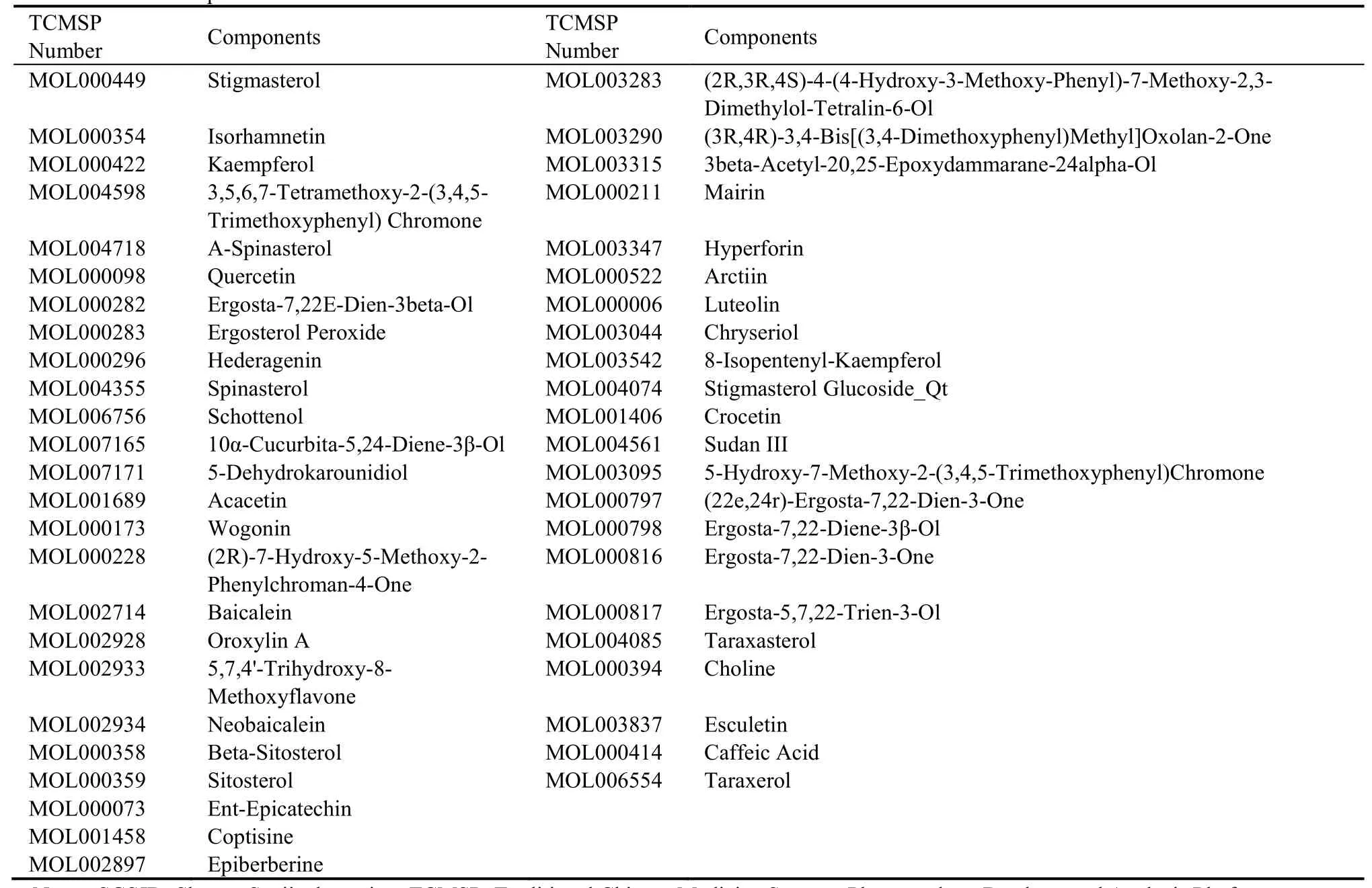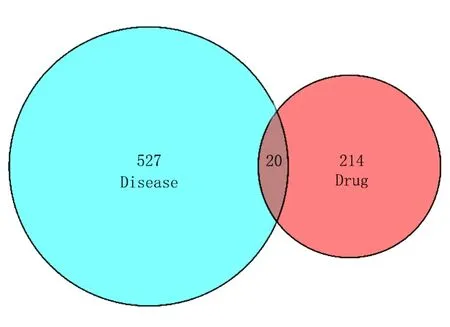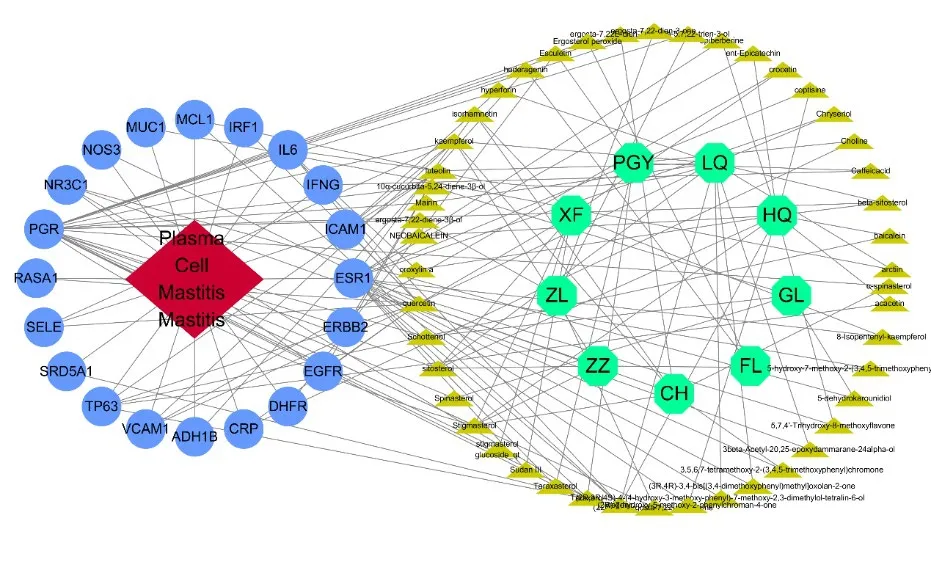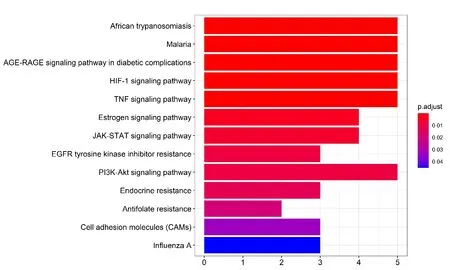Mechanism underlying efficacy of Shugan Sanjie decoction (疏肝散结汤) on plasma cell mastitis,based on network pharmacology and experimental verification
2022-07-20QIAONanWANGQinnanMAChaoqunCHENDexuanCHENHaidongLUYaoyao
QIAO Nan,WANG Qinnan,MA Chaoqun,CHEN Dexuan,CHEN Haidong,LU Yaoyao
QIAO Nan,CHEN Haidong,Department of general surgery,Nantong Hospital Affiliated to Nanjing University of Chinese Medicine,Nantong 226001,China
WANG Qinnan,Department of science and education,Affiliated Nantong Hospital of Shanghai University,Nantong 226000,China
MA Chaoqun,CHEN Dexuan,LU Yaoyao,Department of general surgery,Affiliated Hospital to Nanjing University of Chinese Medicine,Nanjing 210029,China
Abstract OBJECTIVE:To investigate the mechanism underpinning the effeicay of Shugan Sanjie decoction (疏肝散结汤,SGSJD) on plasma cell mastitis (PCM) based on network pharmacology,and to verify it through in vitro.METHODS:Traditional Chinese Medicine Systems Pharmacology Database and Analysis Platform and Bioinformatics Analysis Tool for Molecular mechanism of Traditional Chinese Medicine were used to screen effective compounds and drug targets;Online Mendelian Inheritance in Man and GeneCards were used to search for PCM targets.The potential targets of SGSJD in treating PCM were obtained after the drug targets and disease targets were crossed.Cytoscape software was used to establish and analyze the network of Chinese medicines-active compounds-targets-disease;STRING database platform was used to analyze Protein Protein Interaction network;Bioconductor software package was used to perform Gene ontology and Kyoto Encyclopedia of Genes and Genomes enrichment for potential targets.Western blot analysis was used to verify the janus kinase/signal transducer and activator of transcription(JAK-STAT) pathway in vitro.RESULTS:(a) 47 potential pharmacological components of SGSJD treatment of PCM were screened including quercetin,luteolin,kaempferol and others;20 common targets were obtained,including interleukin-6 (IL-6),epidermal growth factor receptor,estrogen receptor 1,nitric oxide synthase 3 and others;a number of signal pathways were available,of which advanced glycation end product/ receptor for advanced glycation end products signaling pathway in diabetic complications,hypoxia-inducible factor 1 signaling pathway and janus tyrosine kinase-signal transducer and transcription activator (JAK-STAT) signaling pathway were the main signal pathways related to PCM.(b) Compared with the Blank group,the expressions of p-JAK2/JAK2,p-STAT3/STAT3 and IL-6 protein in the Model group were significantly increased (P < 0.01);Compared with the Model group,the expression of p-JAK2/JAK2,p-STAT3/STAT3,and IL-6 protein in the treatment group were significantly reduced in a dose-dependent manner(P < 0.05).Compared with the Model group,the dexamethasone significantly reduced the expression of p-JAK2/JAK2,p-STAT3/STAT3,and IL-6 (P < 0.01).CONCLUSIONS:The SGSJD may regulate the JAKSTAT signaling pathway to achieve the effect of treating PCM by reducing the expression of p-JAK2/JAK2,p-STAT3/STAT3 and IL-6 in a dose-dependent manner.
Keywords:plasma cells;mastitis;network pharmacology;molecular mechanism;Shugan Sanjie decoction
1.INTRODUCTION
Plasma cell mastitis (PCM) is a chronic non-bacterial breast inflammation characterized by mammary duct dilation and plasma cell infiltration.It is clinically characterized by non-periodical breast swelling and pain,nipple discharge,and recurrent lumps and sinuses in the areola area.1At present,Western medicine believes that the cause of the disease is not clear,mainly related to factors such as milk duct blockage and poor milk excretion.Surgery is the most effective method of treatment,but there are some shortcomings such as certain surgical risks,pain,affecting the appearance of breasts and breastfeeding function.2Non-surgical treatment includes anti-inflammatory,antibacterial,antiestrogen,lavage and other methods.
Traditional Chinese Medicine believes that PCM is mainly related to liver-Qistagnation and heat removal,insufficient congenital endowment,seven emotions injures the spleen,damp-heat stagnation steam,Chongren disorder,and exogenous wind-heat,so the treatment principle is to sooth the liver,regulateQiand drain pus.3Shugan Sanjie decoction (SGSJD) is a clinical experienced prescription for the treatment of PCM,founded by Ni Yusheng,a famous Chinese medicine doctor in Jiangsu Province.SGSJD is composed of Chaihu (Radix Bupleuri Chinensis),Huangqin (Radix Scutellariae Baicalensis),Xiangfu (Rhizoma Cyperi),Pugongying (Herba Taraxaci Mongolici),Lianqiao(Fructus Forsythiae Suspensae),Gualou (Fructus et Semen Trichosanthis),Zhizi (Fructus Gardeniae),Jiangchan (Bombyx Batryticatus),Zhuling (Polyporus),and Fuling (Poria),which has the functions of soothing liver and regulating Qi,clearing heat and dispelling congestion,and eliminating phlegm and pus.Clinical studies have confirmed that SGSJD has a good effect on PCM treatment,4,5but its mechanism is still unclear.Besides,Chinese medicine has the characteristics of multi-component and multi-target synergy to exert its efficacy,so it brings challenges to the study of its material basis and mechanism of action.
Network pharmacology believes that drugs act on the human body in a "multi-component-multi-target-multidisease" manner.This provides new ideas for study on Chinese Medicines of the pharmacodynamic material basis,target and mechanism.In recent years,more and more scholars have applied it to the research to find the material basis and mechanism of the efficacy of Traditional Chinese Medicine,and have achieved good research results.6,7In this study,the network pharmacology method was used to study the mechanism of SGSJD’s action on PCM,and was verified byin vitrofor providing reference for clinical application and further research.
2.MATERIALS AND METHODS
2.1.Network pharmacology
Screening for active compounds and targets of SGSJD Traditional Chinese Medicine Systems Pharmacology Database and Analysis Platform (TCMSP,http://tcmspw.com/tcmsp.php) is a systems pharmacology platform of Chinese herbal medicines that captures the relationships between drugs,targets and diseases.Therefore,Chaihu (Radix Bupleuri Chinensis),Huangqin (Radix Scutellariae Baicalensis),Xiangfu(Rhizoma Cyperi),Lianqiao (Fructus Forsythiae Suspensae),Gualou (Fructus et Semen Trichosanthis),Zhizi (Fructus Gardeniae),Zhuling (Polyporus),and Fuling (Poria) were searched in the TCMSP (http://tcmspw.com/tcmsp.php) as keywords.Oral bioavailability ≥ 30% and drug-like ≥ 0.18,as screening conditions,were used to obtain active compounds in the prescription.Then,the targets of the active compounds were collected in TCMSP,and the names of the targets were corrected to its official name by the Uniprot database (http://www.uniprot.org) which the species was restricted to humans.
For not included in the TCMSP,Pugongying (Herba Taraxaci Mongolici),Jiangchan (Bombyx Batryticatus)were searched in the Bioinformatics Analysis Tool for Molecular mechANism of Traditional Chinese Medicine(http://bionet.ncpsb.org/batman-tcm/index.php),a database with the same function as TCMSP.Score cutoff ≥20 was used as the screening condition to get the active compounds and their targets.
2.2.Identification of PCM targets
Online Mendelian Inheritance in Man (OMIM,http://omim.org/) is a comprehensive,authoritative compendium of human genes and genetic phenotypes.The Human Gene Database (GeneCards,https://www.genecards.org/) is an integrative database that provides comprehensive information on all annotated and predicted human genes.Plasma Cell Mastitis was searched in the OMIM database and the GeneCards database as a keyword to obtain the disease targets.After the duplicate genes were eliminated,the remaining disease targets were used for this research.
2.3.Common targets of SGSJD and PCM
The targets of SGSJD and PCM were intersected to get the common targets by R,which were the potential targets of SGSJD in the treatment of PCM.
2.4.Construction of a component-target-disease network
The common targets were imported into Cytoscape 3.7.0 software (Free Software Foundation,Boston,MA,USA)for visualization so as to construct a network of medicinal materials-active compounds-targets-disease.Then the network was analyzed by the network topology in which Degree and Betweenness centrality were used to reflect the importance of the "node".The greater the value of Degree and Betweenness centrality,the more important the "node" was in the network.
2.5.Construction of protein protein interaction (PPI)network
The common targets were imported into the STRING database to obtain the relationship between these targets,called PPI relationship.The PPI relationship was visualized by Cytoscape 3.7.0 to generate the PPI network for getting the core protein.
2.6.Analysis of Gene ontology (GO) function and Kyoto Encyclopedia of Genes and Genomes (KEGG)pathway enrichment
Genes encoding common targets were imported into the Bioconductor biological information software package(http://www.bioconductor.org/) for analysis of GO and KEGG enrichment under the condition ofP< 0.01,which can obtain the main biological function of the targets of the active compounds and the potential mechanism of SGSJD in treating PCM.
2.7.In vitro
Animals
BALB/c mice,aged 6-8 weeks (25-35 g) were purchased from Experimental Animal Center of Zhejiang Province(SCXK,2013-0006).Throughout the experiments,the mice were maintained in plastic cages at (21 ± 2) °C on a 12h light/dark cycle and with free access to food and water.The animal experimental protocols were approved by the Nanjing University of Chinese Medicine Committee on Laboratory Animal Care,and all animals received humane care according to the National Institutes of Health (USA) guidelines.All possible efforts were made to minimize the animals’ pain.
2.8.Preparation of extract
The medicinal materials [Chaihu (Radix Bupleuri Chinensis) 10 g,Huangqin (Radix Scutellariae Baicalensis) 15 g,Xiangfu (Rhizoma Cyperi) 10 g,Pugongying (Herba Taraxaci Mongolici) 30 g,Lianqiao(Fructus Forsythiae Suspensae) 6 g,Gualou (Fructus et Semen Trichosanthis) 10 g,Zhizi (Fructus Gardeniae)6 g,Jiangchan (Bombyx Batryticatus) 6 g,Zhuling(Polyporus) 6 g,and Fuling (Poria) 20 g] were crushed and decocted twice to obtain the water extract.Subsequently,the water extract was concentrated to 1∶1 to 1∶2 (mL∶g).After the liquid was cooled,ethanol was slowly added and stirred to 75% concentration.The above solution was sealed and refrigerated for 24 h and then filtered to obtain a refined solution,which was made into lyophilized powder.Finally,the lyophilized powder was stored at -20 ℃.
2.9.Isolation and culture of mouse mammary epithelial cells
Refer to the literature for the isolation and culture method of primary cells.8The isolated and cultured mammary epithelial cells were seeded in a 6-well plate with 2 mL medium per well,and the cell density was 4×105cells/cm3.When the cells were plated,the experiment was performed.
2.10.Grouping and administration of mouse mammary epithelial cells
This experiment was divided into blank group,model group [lipopolysaccharide (LPS) 1.0 μg/mL],high(750 μg/mL),medium (500 μg/mL) and low (250 μg/mL)dosage group and positive group (dexamethasone 50 μg/mL).The specific steps were as follows:the medium in the 6-well plate was sucked and divided into six groups,the extract solution of lyophilized powder was added to the extract group,the dexamethasone was added in the positive control group,the same volume of culture solution was added to the blank group and the model group,cultured for 1 h separately.Subsequently,LPS with the concentration of 1.0 μg/mL was added to the model group,the extract group,and the positive control group,the same volume of culture medium was added to the blank group,and cultured in a cell incubator at 37 ℃and 5% CO2for 45 min.
The upper culture medium of the six groups was aspirated and discarded,and the cells were gently washed 3 times with precooled phosphate buffered saline at 4 ℃.200 μL of cell lysate was added to each well,shaken at 4 ℃ for 5 min,and then centrifuged at 12000 r/min for 10 min.The supernatant after centrifugation was used for research and was added to protein loading buffer.
2.11.Western blot analysis
Protein expression level was detected by general methods.9The following antibodies were used:BCA protein assay kit (Heart,Xi’an,Shanxi),interleukin-6(IL-6) antibody (1∶1000,Bio-World,Cleveland,Ohio),phospho-signal transducer and activator of transcription(STAT) 3 monoclonal antibody (1∶1000,Cell Signaling,Boston,MA),STAT3 monoclonal antibody (1∶1000,Cell Signaling,Boston,MA),phospho-janus kinase(JAK) 2 monoclonal antibody (1∶500,Cell Signaling,Boston,MA),JAK2 monoclonal antibody (1∶1000,Cell Signaling,Boston,MA),and secondary antibodies (1∶20 000;Merck Millipore,Darmstadt,Darmstadt).
2.12.Statistical analysis
Statistical analyses were performed by SPSS 25.0 software package (IBM Corp.Released 2017.IBM SPSS Statistics for Windows,Version 25.0.Armonk,NY).All data were expressed as mean ± standard deviation.Oneway analysis of variance was used to compare differences between the groups.P< 0.05 was the significant level.
3.RESULTS
3.1.Active compounds and targets of SGSJD
214 drug targets,527 disease targets,and 20 drug-disease common targets were obtained after being screened(Figure 1).Finally,47 potential active ingredients of SGSJD in treating PCM were obtained (Table 1).

Table 1 Active components of SGSJD

Figure 1 Targets of drugs and disease
3.2.Network analysis of herbal medicine-componenttarget-disease
Seventy-seven nodes and 156 edges were obtained by network analysis (Figure 2),of which,Green represented drug,Yellow represented active component,Red represented disease,and Blue represented target.Network topology analysis showed that the average degree value of the network nodes was 4.052,and the average betweenness centrality was 0.026.The core node screening results showed that:the degree value of quercetin,luteolin,kaempferol,stigmasterol,wogonin,sitosterol and dandelion terpene alcohol were greater than the average degree value,and the betweenness centrality of PGR,estrogen receptor 1 (ESR1),TP63,ICAM1,IL6 and VCAM1 NR3C1 were greater than the average betweenness centrality.
3.3.Network analysis of PPI
Nineteen nodes and 72 edges were shown in the PPI,with an average degree of 7.579 (Figure 3).Bar graph showed that IL-6,epidermal growth factor receptor (EGFR),ESR1,nitric oxide synthase 3 (NOS3),IFNG,ERBB2,ICAM1,CRP,MUC1,VCAM1 had larger degree(Figure 4),which may be the key targets of SGSJD in treating PCM.
3.4.Analysis of GO function
DNA-binding transcription activator activity,receptor activity,coenzyme binding,hormone binding and other biological functions played a role in SGSJD in treating PCM (Figure 5).
3.5.Analysis of KEGG pathway enrichment
The analysis of KEGG pathway enrichment showed that the main pathways related to PCM included advanced glycation end products/receptor for advanced glycation end products (AGE-RAGE) signaling pathway in diabetic complications,hypoxia-inducible factor 1 (HIF-1) signaling pathway,TNF signaling pathway,and janus kinase/signal transducer and activator of transcription(JAK-STAT) signaling pathway among the top signaling pathways.
3.6.In vitro results
As the Figure 7 showed,compared with the Blank group,the expressions of p-JAK2/JAK2,p-STAT3/STAT3 and IL-6 protein in the Model group were significantly increased (P< 0.01);compared with the Model group,the expression of p-JAK2/JAK2,p-STAT3/STAT3,and IL-6 protein in the treatment group were significantly reduced in a dose-dependent manner (P< 0.05).The dexamethasone significantly reduced the expression of p-JAK2/JAK2,p-STAT3/STAT3,and IL-6,compared with the Model group (P< 0.01).It was suggested that SGSJD may inhibit the activation of IL-6/JAK2/STAT3 signaling pathway to treat PCM.

Figure 2 Network of herbal medicine-component-target-disease

Figure 3 Network of protein protein interaction

Figure 4 Ranking of key targets

Figure 5 Analysis of GO function

Figure 6 Analysis of KEGG pathway enrichment

Figure 7 Western blot analyses
4.DISCUSSION
Shugan Sanjie decoction is mainly derived from Shenxiao Gualou San and Pugongying decoction,which has the effects of soothing the liver and regulating qi,clearing heat and dispelling stagnation,and resolving phlegm and purging pus.It has clinically definite therapeutic effects for PCM,but its effective ingredients and mechanism of action have not been clear.This article aims to explore the potential material and mechanism of SGSJD in treating PCM performed by network pharmacology methods.
Totally 47 potential effective ingredients and 20 targets were screened from SGSJD,indicating that SGSJD can treat PCM through multi-component and multi-target synergy.The main active ingredients were quercetin,luteolin,kaempferol,stigmasterol,wogonin and others.The main targets were IL-6,EGFR,ESR1,NOS3,IFNG,ERBB2,ICAM1,CRP,MUC1,VCAM1,PGR,TP63,NR3C1 and others.Quercetin has the most potential targets.The study has found that quercetin has a precise regulation of inflammationin vivoandin vitro,and it can play an anti-inflammatory effect through a variety of ways,such as:inhibiting inflammatory cytokines and inflammatory enzymes,reducing the expression of IL-1,IL-6,IL-10 and other inflammatory factors,and regulating PI3K/AKT/NF-κB signaling pathway.10The second potential target is luteolin.The study has found that luteolin can also exert its anti-inflammatory effects through a variety of ways,such as inhibiting inhibiting iNOS activity to reduce NO production from the perspective of oxidative stress,reducing the expression of various inflammatory factors such as IL-1β,IL-4,IL-5,IL-6,IL-8,IL-10,IL-13,TNF-α,interferon-β and granulocytes-Macrophage colony stimulating factor,regulating the metabolism of arachidonic acid to reduce the production of leukotrienes,regulating MAPK and AP-1 signaling pathway and JAK-STAT signaling pathway,and stabilizing mast cells.11Wogonin can regulate immune function by increasing the infiltration of immune cells.12
IL-6,with pleiotropic and versatility,plays an important role in chronic inflammatory autoimmune diseases.13IL-6 signal transduction can activate JAK-STAT.During the development of infection,IL-6 is transiently expressed and triggers an alarm signal to activate the host's defense mechanism;when the stress response is relieved,the IL-6-mediated signal transduction cascade stops.14JAK-STAT can mediate a variety of physiological and pathological processes involving immunity,cell proliferation and differentiation,cell apoptosis,inflammation,and tumors.STAT5 in the STATs family play an important role in breast tissue that can induce milk protein synthesis.In addition to STAT2,other subtypes show periodic changes in the breast,suggesting that they have important functions in the development,lactation and degeneration of the breast.15IL-6 can also activate the hypoxia-inducible factor-1 signaling pathway to generate CD18,eNOS,iNOS and other substances to cause inflammation and vascular damage.16
In conclusion,our findings suggest that quercetin,luteolin,kaempferol,stigmasterol,wogonin are the potential effective ingredients of SGSJD in the treatment of PCM.In vitrostudies have confirmed that the extraction of SGSJD reduced the expression of p-JAK2/JAK2,p-STAT3/STAT3 and IL-6 in a dosedependent manner.We can draw the conclusion that the SGSJD may regulate the JAK-STAT signaling pathway to achieve the effect of treating PCM.However,this study is based on network pharmacology andin vitrousing mouse mammary epithelial cells,and our results need to be further verifiedin vivo.
5.REFERENCES
1.Ortiz-Mendoza CM,Sánchez NAA,Dircio AC.Fine-needle aspiration cytology to identify a rare mimicker of breast cancer:plasma cell mastitis.Rev Bras Ginecol Obstet 2018;40:491-3.
2.Ren FL,Cai XJ.Progress in research of Traditional Chinese And Western Medicine in plasma cell mastitis.Xian Dai Zhong Xi Yi Jie He Za Zhi 2018;27:3303-6.
3.Liu YF,An T,Wang CH,Zhang XM,Xiao JH,Pei XH.Progress on Traditional Chinese Medicine in treatment of plasma cell mastitis.Zhong Yi Xue Bao 2019;34:289-93.
4.Ding XW,Fang Y.92 Cases of mammary duct dilatation treated with Shugan Sanjie decoction.Jiangxi Zhong Yi Yao 2015;46:54-6.
5.Qiao N,Ding XW,Shen H,Ni YS,Fang Y.Clinical observation on the treatment of non-puerperal mastitis in tumor stage by Integrated Chinese and Western Medicine.Zhong Guo Zhong Xi Yi Jie He Wai Ke Za Zhi 2020;26:941-4.
6.Long HP,Lin XY,Wang YH,Ren WQ,Tan YS.Explore mechanism of compound uncaria hypotensive tablet for hypertension based on network pharmacology.Zhong Guo Zhong Yao Za Zhi 2018;43:1360-5.
7.Wang J,Chen YW,Zhao K,Zhao GY,Jiang WW.Study on the molecular mechanism of Zuojin pills in the treatment of hypertension based on network pharmacology.Zhong Cheng Yao 2019;41:1976-81.
8.Malley MJ.Isolation,culture and analysis of mouse mammary epithelial cells.Methods Mol Biol 2010;633:139-70.
9.Lin J,Wu G,Chen J,et al.Electroacupuncture inhibits sodium nitroprusside‑mediated chondrocyte apoptosis through the mitochondrial pathway Mol Med Rep 2018;18:4922-30.
10.Ma N,Li YJ,Fan JP.Research progress on pharmacological action of quercetin.Liaoning Zhong Yi Yao Da Xue Xue Bao 2018;20:221-4.
11.Yu Q,Wu GZ.Research progress of anti-inflammatory properties of luteolin.Yao Xue Yan Jiu 2019;38:108-11.
12.Xiao WM,Bo P,Gong WJ.Advance in studies on antitumor and immunomodulatory effects of wogonin.Zhong Guo Zhong Yao Za Zhi 2014;39:3004.
13.Zhang WJ,Zhen H.Progress of IL-6-mediated immunoinflammatory response and its relationship with diseases.Xi Bao Yu Fen Zi Mian Yi Xue Za Zhi 2017;33:699-703.
14.Li L,Zhang HC.Progress on the relationship between IL-6 and its JAK-STAT3 signaling pathway and myocardial remodeling.Kong Jun Yi Xue Za Zhi 2009;25:23-5.
15.Huang TY,Li QZ,Hou XM.Progress on JAK-STAT function in mammary gland.Zhong Guo Ru Pin Gong Ye 2010;38:41-4.
16.Yu B,Huang SH,Zhang TS,Wang Y.Interleukin-6 as a therapeutic target on inflammatory disease and Castleman's disease.Wu Jing Hou Qin Xue Yuan Xue Bao 2017;26:634-6.
猜你喜欢
杂志排行
Journal of Traditional Chinese Medicine的其它文章
- Microecology-turbidity toxin theory:correlation between helicobacter pylori infection and manifestation of tongue and gastroscopy
- Integration strategy of network pharmacology in Traditional Chinese Medicine:a narrative review
- Risk assessment and analysis of Traditional Chinese Medicine intervention in coronavirus disease
- Transcutaneous auricular vague nerve stimulation improved brain connection activity on patients of disorders of consciousness:a pilot study
- Sterile alpha motif and histidine-aspartic acid domain-containing protein 1 expression and its relationship with T cell activation in human immunodeficiency virus/acquired immune deficiency syndrome patients with lung-spleen Qi deficiency syndrome pattern
- Effect of decoction of Fuzheng Jiedu Xiaoji formula (扶正解毒消积方) plus chemoembolization on primary liver cancer in patients
